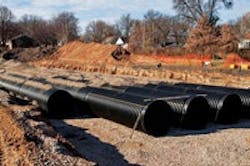About the author: Steve Cooper is a writer for SCA Communications. Cooper can be reached at [email protected] or 516.623.7615.
Taking a swampy, flooded area in a major city and efficiently converting it into a park and public green space is not an easy task. For the Hillcrest Knoll Park in St. Paul, Minn., the
solution was to use more than 2,500 ft of 60-in.-diameter corrugated high-density polyethylene (HDPE) pipe to construct an underground retention system capable of storing 85,000 cu ft of water.
Completed in 2012, it was awarded “Project of the Year” by the Plastics Pipe Institute Inc. (PPI) for the trade association’s Corrugated Plastic Pipe Div., and is now considered a benchmark for drainage retention best management practices (BMPs).
“HDPE pipe was the ideal product solution for this retention system, in part because it offers an unmatched service life,” said Tony Radoszewski, executive director of PPI. “In addition, a plastic pipe system can be configured to specific needs because the pipe allows for a custom-designed solution that maximizes the efficiency of each project, saving valuable time and money. This was especially true for the Hillcrest Knoll Park system, and one reason it was voted ‘Project of the Year’ by our members.”
A History of Issues
The area encompassing Hillcrest Knoll Park has a history of ongoing flooding problems, including flash floods. It was a swamp in the early 1900s, but was developed in the 1950s during the post-World War II housing boom. After troubleshooting the problems, St. Paul created the park as a public green space. In 2012, the city determined that additional storm water management was needed to mitigate flooding issues within the park and nearby homes. Considering the flooding history of the region and the large geographic area involved, it was determined that a substantial BMP drainage retention system was needed.
Carl Douglass, P.E., director of engineering for the pipe manufacturer, Prinsco Inc., explained, “This project is a perfect example of how high-performance HDPE pipe can help solve difficult water management challenges. The structural integrity of the pipe coupled with the versatility of custom-fabricated structural fittings allowed the system to be optimized for the project requirements, resulting in time and cost savings. The overall project footprint was reduced by upsizing pipe in certain areas and even eliminating pipe in other areas, ultimately accomplishing immediate cost savings for the city.”
Tailored to Fit
HDPE pipe allowed the system to be tailored to fit specific site conditions while meeting the high volume storage requirements, saving material and labor costs and providing a pipe system with superior service life. Originally, the proposed retention system would fill the entire footprint of Hillcrest Knoll Park. The final system design used Prinsco’s 60-in.-diameter Goldflo WT corrugated HDPE pipe. The large-diameter HDPE pipe reduced the footprint required for the system, which eliminated the need to excavate an additional 3,500 sq ft of land and reduced the footage of pipe by several hundred feet. Despite the large scale of this retention project, the contractor installed it in just three days. The efficient installation timeline was attributed to the ease of product handling, convenience of the HDPE pipe’s bell/spigot joint system and ongoing engineering support from Prinsco.
The corrugated HDPE pipe meets the material requirements of AASHTO M294. Although the area above the retention system is a green space and does not have any paths for vehicular traffic, the system was designed to withstand loading from an occasional vacuum truck for cleaning. With a minimum of 2 ft of final cover, this system is suitable for H-25 live loads.
The inert nature of HDPE means that the pipe system will not deteriorate due to standing water even if that storm water contains road salts from winter and spring de-icing. The result is structural integrity and material properties that will provide an extensive service life.
Project of the Year
Functionally, the system was designed to direct storm water into a segment of pipe that uses a weir plate to trap initial runoff, isolating sediment to maximize the service life of the system and to make periodic clean-out easier. Storm water then enters a manifold that disperses the water across nine rows of 60-in. perforated pipe. The storm water then can percolate into the subsurface soil, promoting groundwater recharge. As a result, the system operates as a BMP by providing storm water quantity and quantity controls and promoting infiltration and groundwater recharge.
“Large-diameter corrugated HDPE pipe underground retention and detention systems are helping to manage volumes of water in residential and commercial areas where storm water runoff from impervious surfaces can become a problem,” Radoszewski said. “This retention system made a water peril into a park and contributed to the enhancement of the St. Paul community, and can be used as a template for others as a best management practice. That definitely qualifies it as an impressive choice for the PPI Project of the Year.”
Download: Here
About the Author
Steve Cooper
Steve Cooper is a writer for SCA Communications. Cooper can be reached at [email protected].
